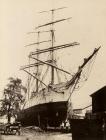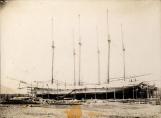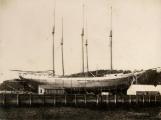14
The Edna M. Smith at some unknown dry dock having repairs done.
19 September 1930

15
Twenty-two ships were built at the Turner shipyard in Harvey including the largest ship every built in New Brunswick, the Annie E. Wright, built in 1885. The Annie E. was 238 feet long, 43 feet wide and 24 feet deep, with a registered weight of 1863 tons. On Saturday June 15th a crowd of 2,000 people gathered to watch the launch of the Annie E. Wright. Two special trains of nine cars each arrived full of spectators eager to watch the launch of the ship. The steam ship "Ripple" made a special trip from Moncton carrying more spectators to watch the vessel being launched. Unfortunately a gale forced the launch of the vessel to be put off until Monday, much to the chagrin of the spectators.
The last of the tall ships built in Albert County were the Meredith A. White and the Vincent A. White, built in Alma in 1918 for C.T. White and Son Ltd.
16
The Vincent White under construction in Alma in 1918.
19 September 1918
Alma, New Brunswick, Canada

17
The Meredith White under construction in Alma in 1918.
19 September 1918
Alma, New Brunswick, Canada

18
The ships were named for C.T.'s twin children. After they were launched they were loaded at Apple River, Nova Scotia, and sailed to South Africa. Wooden ships stopped being constructed in Albert County for several reasons. One reason was because of a lack of demand for new ships, there were already enough ships on the oceans of the world to fill the demand for transporting cargo between the various markets. Companies also began to pay less to ship cargo, so only those who built large ships received new ship orders, because larger ships could carry more cargo and were more profitable. Unfortunately few ship builders in Albert County built such large vessels. The third reason was because investment in railways and other ventures had become more profitable than investing in building ships. At the same time Britain no longer gave special consideration to purchasing materials from its colonies, so there was no longer a guaranteed market for lumber and other products produced in the area. Above all else, the movement towards building more Iron Ships and less wooden ships in the early twentieth century brought to an end the "Golden Age of Sail". In Albert County no shipyards modernized to build iron ships because it was cheaper to build wooden vessels. It was also impossible to get iron and steel in the County since no business here produced it. Shipbuilders would have had to import the material from other areas, which would have been very costly and difficult to keep construction on schedule. Building wooden ships required less capital than was required to build iron ships. Iron ships required modern shipyards and expensive construction materials so only major shipbuilding centers like Britain with its access to more capital could afford to build this new type of ship.


